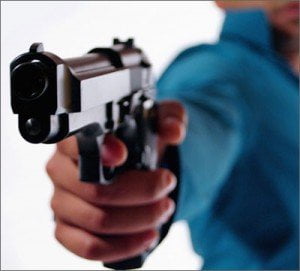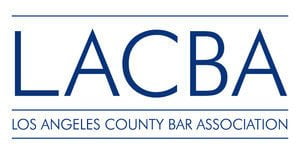According to California 245(a)(1) PC, assault with a deadly weapon (ADW) occurs when 1) someone is assaulted and 2) the assault was committed with a deadly weapon or some other force that was likely to cause great bodily harm.

Although weapons like guns and knives are obviously deadly, this law also covers the use of improvised weapons such as baseball bats, golf clubs, motor vehicles, acids or other caustic chemicals, etc.
245(a)(1) PC is a wobbler offense, which means that it can be charged as a misdemeanor or felony, and carries potentially severe criminal penalties.
The crime of assault with a deadly weapon (ADW) is defined in California Penal Code 245(a)(1), which lays out the elements and penalties for this offense.
Elements of the crime of ADW
In order to obtain a successful conviction for a charge under 245(a)(1) PC, the prosecution must prove beyond a reasonable doubt the following:
- The defendant assaulted another person.
- The assault was committed with a deadly weapon or another type of force that was likely to cause great bodily harm.
Under California law, an assault occurs when a person – referred to as the assailant – willfully and unlawfully attempts to harm another person and cause great bodily harm, when the assailant has the ability to do so.
For the purposes of this law, a deadly weapon or force is anything that can be used to cause great bodily harm – meaning significant physical injuries. This includes obvious weapons like knives and guns, but also encompasses other items which could serve as improvised weapons such as baseball bats, crowbars, screwdrivers, golf clubs, motor vehicles, caustic chemicals, and even dogs, for example.
Related offenses
If the defendant’s actions do not rise to the severity of ADW, lesser related offenses may be charged, such as:
- Simple assault, 240 PC
- Battery or battery causing serious bodily harm, 242 PC
- Brandishing a weapon, 417 PC
- Assault on a public official, 217.1(a) PC
- Failure to control a dangerous animal, 399 PC
Criminal penalties for ADW
245(a)(1) PC is a wobbler offense, which means that it can be charged as a misdemeanor or felony depending on the totality of circumstances, any prior criminal history of the defendant, what type of weapon was used, and whether the victim was injured and to what extent.
A misdemeanor conviction is punishable by any or all of:
- Up to one year in county jail, with a mandatory six-month minimum if a firearm was used.
- A fine of up to $10,000.
- Victim restitution.
- Confiscation of the weapon.
- Community service.
- Successful completion of an anger management course.
For a felony charge, the potential criminal penalties include any or all of:
- Two to four years in state prison.
- A fine of up to $10,000.
- Victim restitution.
- Confiscation of the weapon.
- A strike under California’s Three Strikes law if the ADW was against a peace officer or firefighter, if the defendant used a firearm, or if the defendant actually inflicted great bodily harm to the victim.
Sentencing enhancements for ADW
In keeping with California’s three strikes law, a defendant with a prior strike for ADW who is subsequently convicted of another California felony will automatically receive double the sentence for that subsequent felony. A third strike is punishable by a sentence of 25 years to life.
Enhanced penalties apply if the defendant used a firearm — particularly restricted or prohibited firearms such as a rifle or shotgun designated as an “assault weapon” under California law, a fully automatic firearm (aka “machine gun”), or a rifle chambered for the .50 BMG cartridge.
If the defendant committed ADW on a law enforcement officer, other peace officer, or firefighter engaged in the performance of their duties — and knew or should have known that the victim belonged to this statutory protected group — the defendant will be charged with a felony and subject to three to five years in state prison if a gun was not used in the assault. But if a firearm was involved, the penalties increase to:
- Four to eight years for a manual-operation firearm, such as a revolver, pump-action shotgun, or bolt-action rifle.
- Five to nine years for a semiautomatic firearm.
- Six to 12 years for a fully automatic firearm, California-designated assault weapon, or .50 BMG rifle.
Legal defenses for ADW
Assault with a deadly weapon is a serious offense that carries substantial criminal penalties. Anyone accused of violating 245(a)(1) PC should immediately seek legal advice from a qualified attorney. Only an attorney can provide accurate legal advice and determine the appropriate defense strategy. Common defense strategies include, but are not limited to:
Inability to cause injury
ADW requires the capability to commit great bodily harm. For example, if the defendant allegedly threatened to shoot another person with an unloaded gun, the defendant did not have the ability to commit great bodily harm and the elements required for an ADW conviction do not exist.
Self-defense and/or defense of others
If the defendant reasonably believed that they or another person was about to be seriously injured and the defendant acted in order to protect themselves or others, the use of deadly force was justified and does not constitute ADW.
Lack of intent
A required element for a charge of ADW under California law is that the defendant must have acted willfully with the intent to cause great bodily harm. Absent this intention, ADW did not occur.
Mistaken identity
If the defendant is wrongfully accused and the defense attorney is able to cast sufficient doubt upon key evidence such as eyewitness testimony, the accused should be found not guilty of ADW.









